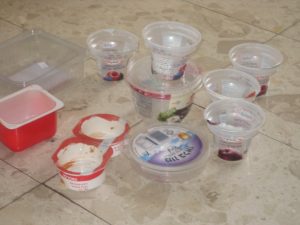 Driving 22 East from Somerville I saw an industrial zone I had never seen before. I made a right, which took me past the county sewage plant to the Somerset County Recycling Center. Massive trucks that I only used to see on Tuesdays in my hometown were lined up to dump their day’s collections.
Driving 22 East from Somerville I saw an industrial zone I had never seen before. I made a right, which took me past the county sewage plant to the Somerset County Recycling Center. Massive trucks that I only used to see on Tuesdays in my hometown were lined up to dump their day’s collections.
I grew up in Somerset County, NJ and had been recycling there since the plant opened in 1992. I took it for granted most of my life that I could recycle, and it took moving to Tel Aviv to make me realize how relatively progressive recycling has been in the past 20 years—and how behind the Middle East is on this front. (Although GP recently reported about Israel’s first municipal reuse center).
I’ve been in New Jersey for the past few weeks awaiting the birth of my future nephew/niece, so I signed up for a tour of where I have sent my recyclables as an adolescent, to see just how one small county does it. Overlooking the plant from a management window I spoke with Melissa Harvey, the Recycling Coordinator of the plant. “You can see that Shoprite or Pathmark had a sale on Tide,” she said as she pointed to the red laundry detergent containers standing out amidst the heap. She also knew what the most popular products are in Somerset County just from looking at what is, essentially, a daily graph of consumer spending habits.
Coca Cola is the most popular soda beverage. The most popular water? “Poland Spring, without a doubt,” Melissa laughed. The possibilities for analyzing how our society consumes are endless, it seems, looking at this ultra fascinating waste stream.
I kept on asking Melissa for insight into our consumer patterns and our society, and she wasn’t really used to responding to such broad questions. It does pain her to see how much waste we have, and it pains her even more to throw kitty litter buckets and plastic bags away because their facility cannot hold them. She got into this for the social good it does in this world, though she does not appear to be the typical environmentalist, which is probably for the best given the limits these recycling centers have.
Most amazing was seeing the unending stream of products entering the large garages. It made me feel small. As much as I fill my water bottle with tap water or compost or reuse my glass jars, I am just one person who has hardly made any difference on Somerset County’s waste build-up.

What I was most interested in learning was where everything went. The industry lingo is in terms of “markets.” Melissa explained the markets for the #1 and #2 plastics, cardboard and paper, glass, aluminum and bi-metal cans. The cardboard and paper are purchased by Chinese companies. So much of our products are shipped in those boxes from China, that we just send it back to them to reprocess and convert it back into cardboard shipping material. Cardboard has many lives. #1 plastics from Somerset County—mainly soda bottles—are sold to a supplier for Eastern Mountain Sports, making the very fleece I was wearing on my tour. Thus soda bottles have 2 lives, although an EMS fleece is usually a good quality fleece, makng the plastic’s second life a good one.
#2 plastics have a more interesting use: replacement for wood. All the vinyl siding in the suburbs and new plastic boardwalks on the Jersey shore are made with recycled #2 plastics. Even decks are being built with the stuff. Melissa listed off a few companies who specialize in this field, as well as various industries using the recycled by-product of the 2s. “Are they used for train tracks?” I asked her. “Even train tracks,” she affirmed. My mind went running with excitement as I contemplated California’s proposed train route between San Francisco and Los Angeles. Could it be that California will use #2 plastics instead of wood? Melissa was pretty sure that they would.
Glass was a disappointment. I tend to prefer glass because it is most reusable (you can never have too many jars), though I’ve always been a bit disappointed at how heavy it is and how problematic it is for shipping weights. Recently the New York Times ran an opinion piece lambasting the wine industry for shipping cheap wine in glass bottles across the world—for table wine, the writer argued, vineyards should adopt the boxed wine approach. I agreed. The process for glass involves sorting the broken glass from the full bottles, then smashing the full ones so it’s all broken. Then it all goes through a machine to further crush the glass back into its original sand form, though a bit larger and still glassy. Ever wonder what those huge cones of “sand” on the side of highways in New Jersey are? I did too. They house crushed recycled glass.
“Are companies buying these shards to melt down and make new glass bottles?” I asked Melissa. How Naïve of me. The shards are mixed with asphalt and used for roads. “Kids love when I tell them that the sparkles in asphalt are glass,” Melissa joked. She spoke about giving tours to kids a lot which made me feel as if not many adults show as much of an interest in our waste streams, which is unfortunate. I guess road building is useful, but I was hoping that the glass would be recycled into new glass. That’s apparently what happens with aluminum cans. Within six months of processing them they are usually purchased by Anheuser-Busch, made into new cans, and filled with cheap beer.
Melissa stressed a few points that would make her job easier: for those who live in areas that don’t recycle all plastics, always unscrew your soda tops and toss the tops in the garbage, because that’s just what the workers end up doing at the recycling center, with a kind of distain. Also, don’t expect plastic bags to get recycled. Many people apparently wrap their recyclables in plastic bags. Unfortunately those bags make it difficult for the laborers. It also costs too much money to bring those bags to a facility that does recycle them, so they make their way to the landfill. Somerset County spends half a million dollars to dump residents’ bags for them, when supermarkets in New Jersey must recycle the bags for you.
The center is feeling the economic decline. It’s in the red now. Suddenly aluminum, its best seller overall, is only going at a low price. The bids from companies are shrinking, and Melissa estimates that it will take at least 18 months to get on solid footing again. Today New Jersey has a 54% recycling participation rate with the hopes of moving to 60%. Somerset County has a 56% rate, just above the average. There are goals and plans for the future that—ironically—will rely on a more wasteful economy to get started up again.




Question, did you find out how the computers and monitors are recycled? I live in North Plainfield and been considering giving my old computer for recycling but I wasn’t sure if they audited their recyclers like Dell does. What I found out according to a January/February 2008 edition of Mother Jones magazine is that most computers when their recycled wind up going to plants in China where the re-usable parts are taken out by workers and the rest disgarded. I’m not sure how much it actually matters in terms of recycling but could you let me know? Thanks
How interesting, thank you! Sure wish the Courier News (local paper, c-n.com) had articles like this — in fact I suggest you freelance this article to them or the Star Ledger if you like. Make sure they pay you. I live in Somerset County and am glad to learn all the info you report here. I admire Melissa, the recycling coordinator, for her good and transparent work — but suggest that she communicate those important facts — unscrew tops off pop bottles, don’t include kitty litter or plastic bags because they hurt the program, etc. — to residents. Already other info is sent and published by the department, it would be easy enough to communicate this as well. Of course it would be easier to sort and instruct if there were more catagories of plastic, etc. so that people could just leave out the “Number 8 Plastic” — or better, find actual markets for all kinds of waste. (Or even better, not buy things that can’t be recycled).